Posts: 748
Threads: 0
Likes Received: 2 in 2 posts
Likes Given: 0
Joined: Aug 2006
Reputation:
3
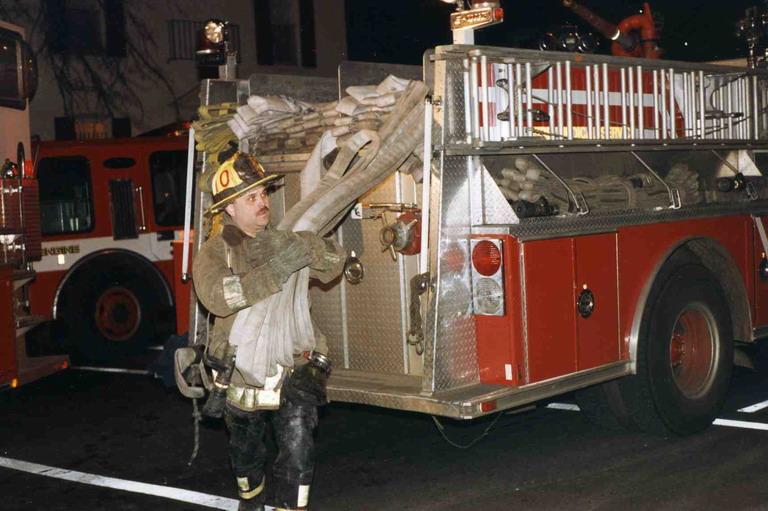
[quote name='derry86' post='137485' date='Aug 6 2007, 18:50 ']Question about DC Hoseloads....... Thanks!!
Rob[/quote]Hi, Rob. Just affirming what Cosgrove said.
The idea behind the long 1 ½” line is speed in placing it in service. As practiced, the 350’ or 400’ line is a three-man evolution. In practice, as in this 1995 photo taken of Engine 10 on the fireground, one person can shoulder as much as he can, and grab, drag and flake the rest on the run. Apparatus is a 1991 Ford/ E\-One
Kevin Byrne
Posts: 748
Threads: 0
Likes Received: 2 in 2 posts
Likes Given: 0
Joined: Aug 2006
Reputation:
3
Posts: 748
Threads: 0
Likes Received: 2 in 2 posts
Likes Given: 0
Joined: Aug 2006
Reputation:
3
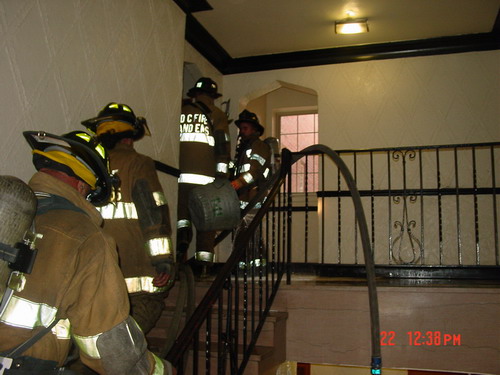
And it’s easy to work around.
Kevin Byrne
Posts: 748
Threads: 0
Likes Received: 2 in 2 posts
Likes Given: 0
Joined: Aug 2006
Reputation:
3
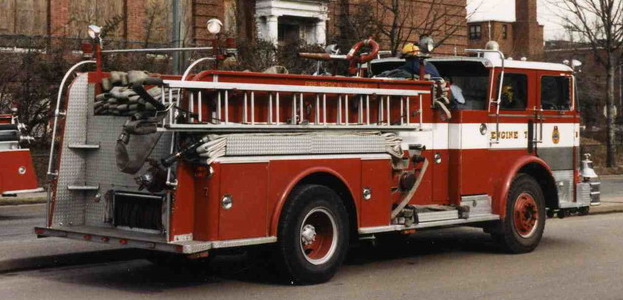
Up until 1980, 100’ 1 ½” standpipe rolls were carried in a canvas bag, sort of like a paperboy’s sack. A company would race to the fire floor and throw the roll from a window, whereupon a wagon driver would attach them to a preconnected 1 ½” line. After the Hahns came in, the standpipe bags were discarded in favor of standpipe racks, where 100’ of 1 ½” and all accouterments were held together with canvas straps and Velcro, draped over the motor cowling. This lead to the tactic of running a 350’ into a building as far as it could go, then extending it with a rack. Even cheap double jacket hose has a burst pressure of 1200 PSI, an acceptance test pressure of 800 PSI, a service test of 400 PSI. Any pump is good for 300 PSI. DCFD could then stretch lines from here to Sunday.
Kevin Byrne
Posts: 748
Threads: 0
Likes Received: 2 in 2 posts
Likes Given: 0
Joined: Aug 2006
Reputation:
3
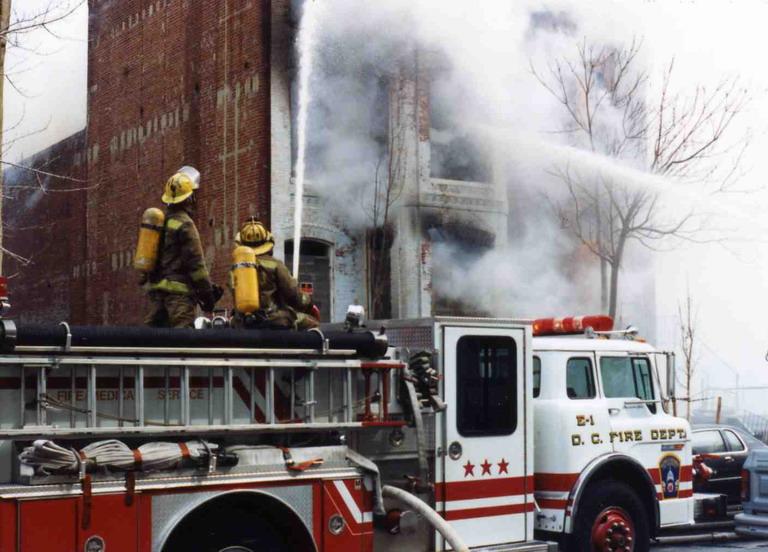
Starting in 1986, DCFD wagons reserved the space atop the right side compartments for carrying standpipe racks and maintain that configuration today. April 1992 photo is Engine 1’s 1987 Ford/ E\-One working 11th and O Sts. NW.
Kevin Byrne
Posts: 748
Threads: 0
Likes Received: 2 in 2 posts
Likes Given: 0
Joined: Aug 2006
Reputation:
3

Engine 22’s 1990 Ford/ E\-One with standpipe racks.
Kevin Byrne
Posts: 748
Threads: 0
Likes Received: 2 in 2 posts
Likes Given: 0
Joined: Aug 2006
Reputation:
3
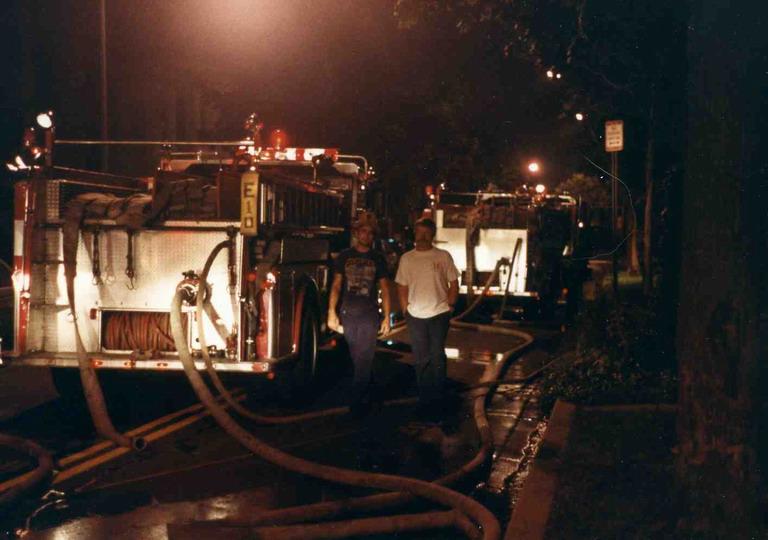
Engine 10’s 1983 Hahn and Engine 8’s 1981 Hahn each sending their 350' around the corner to an apartment fire in 1985. Jim Lloyd and Tommy Reed pictured.
Kevin Byrne
Posts: 748
Threads: 0
Likes Received: 2 in 2 posts
Likes Given: 0
Joined: Aug 2006
Reputation:
3

The story is still the same in July 2004. The fire is at the end of the block behind the photographer. The companies at this end of the block have opted to stretch 350’s, considering it quicker than grabbing a line from an alternate company closer to the fire. As Cosgrove said, it’s a DC thing. Also, here is a different view of seldom seen Air Unit 3, not quite as good as BCFDT782’s image.
Kevin Byrne
Posts: 748
Threads: 0
Likes Received: 2 in 2 posts
Likes Given: 0
Joined: Aug 2006
Reputation:
3
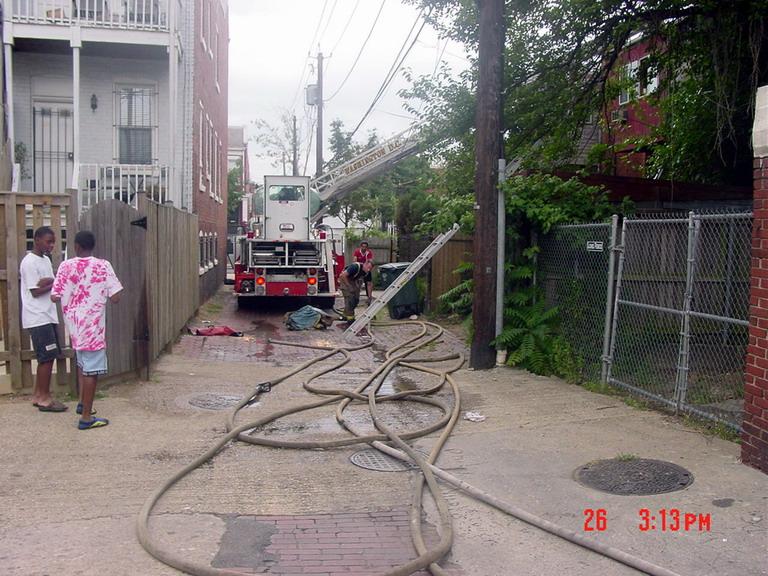
You would think they’re making more work for themselves, but some companies are so adept and swift in stretching and extending a 350 that they do it on a 2-story row. That’s the case here, evidenced by the shut-off in the middle of the line and that empty red standpipe rack cover. August 2002 photo, North Capitol St. and Girard St. NE, Truck 6
Kevin Byrne
Posts: 748
Threads: 0
Likes Received: 2 in 2 posts
Likes Given: 0
Joined: Aug 2006
Reputation:
3

One drawback to the DC 350 is knowing when to flake it (as in this November 2002 photo) and when to let it play out straight. Engine 9’s 2000 Cyclone too big for the turn. You can see 9's crosslays haven't been used; two 350's have been stretched down this alley.
Kevin Byrne
Posts: 748
Threads: 0
Likes Received: 2 in 2 posts
Likes Given: 0
Joined: Aug 2006
Reputation:
3
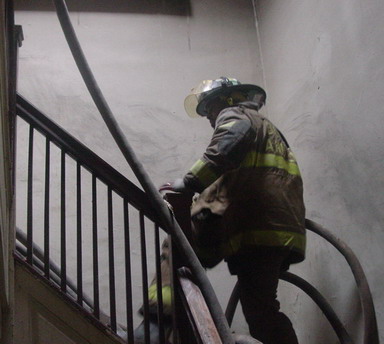
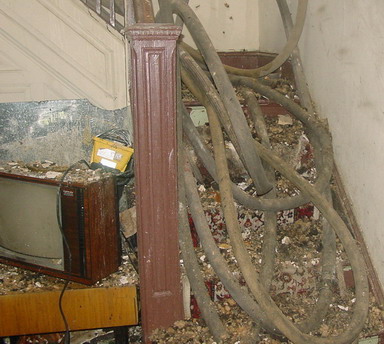
…didn’t flake enough.
Kevin Byrne
Posts: 748
Threads: 0
Likes Received: 2 in 2 posts
Likes Given: 0
Joined: Aug 2006
Reputation:
3
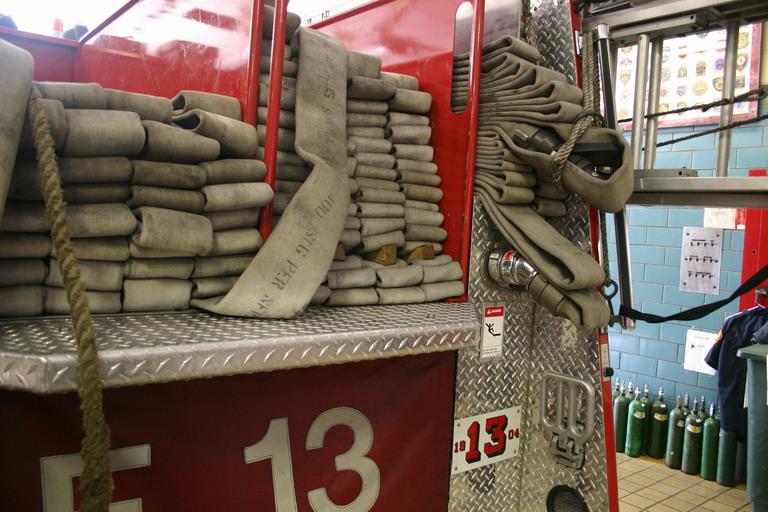
When stretching a 350 from E-13's 2005 Seagrave, members grab a chock from the right side 3” bed for doors encountered on the way up.
Kevin Byrne
Posts: 748
Threads: 0
Likes Received: 2 in 2 posts
Likes Given: 0
Joined: Aug 2006
Reputation:
3
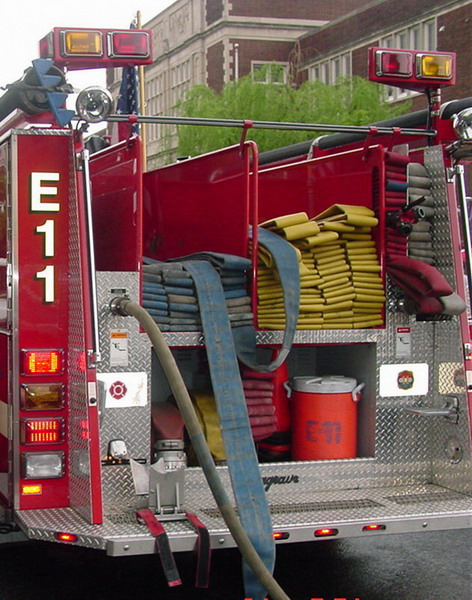
As Derry86 brought up, some companies prefer a leader line arrangement. 2002 photo of E-11.
Kevin Byrne
Posts: 748
Threads: 0
Likes Received: 2 in 2 posts
Likes Given: 0
Joined: Aug 2006
Reputation:
3
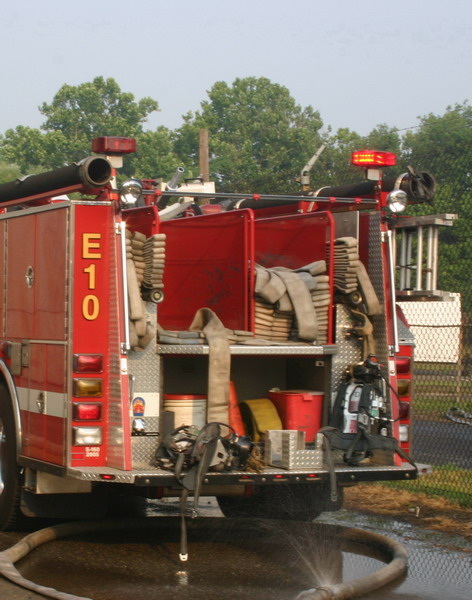
On the other hand, Engine 10 – whose Local Alarm area is a plethora of 2-story rows and taxpayers – prefers multiple versions of long lines. 2007 photo. 2005 Seagrave
Kevin Byrne
Posts: 748
Threads: 0
Likes Received: 2 in 2 posts
Likes Given: 0
Joined: Aug 2006
Reputation:
3

Summing up – the idea behind DC’s 350 is speed speed speed in getting water to the fire; five engines equals 500 GPM in seconds. This 2001 image on Lamont St. NW, taken from the side window of the buggy on the opposite sidewalk, shows E-11 advancing an 1 ½”. E-9 is stretching the 350 from around the corner. Look at the time line.
Kevin Byrne
Posts: 748
Threads: 0
Likes Received: 2 in 2 posts
Likes Given: 0
Joined: Aug 2006
Reputation:
3

The stick isn’t quite to the roof yet…
Kevin Byrne
Posts: 748
Threads: 0
Likes Received: 2 in 2 posts
Likes Given: 0
Joined: Aug 2006
Reputation:
3

Five minutes into it…
Kevin Byrne
Posts: 748
Threads: 0
Likes Received: 2 in 2 posts
Likes Given: 0
Joined: Aug 2006
Reputation:
3
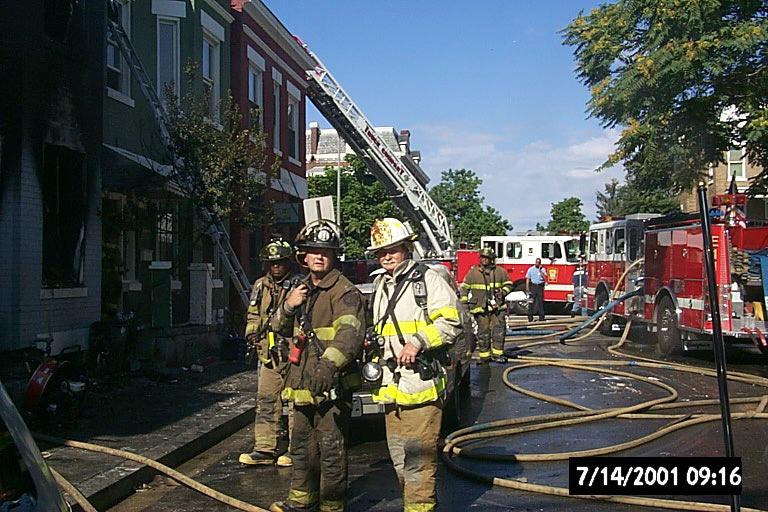
Just a few minutes later and we’re posing in front of fire trucks, in part due the speed in being able to place multiple 1 ½” lines in service – and the 350’ pre-connect played a part.
Kevin Byrne
Posts: 748
Threads: 0
Likes Received: 2 in 2 posts
Likes Given: 0
Joined: Aug 2006
Reputation:
3
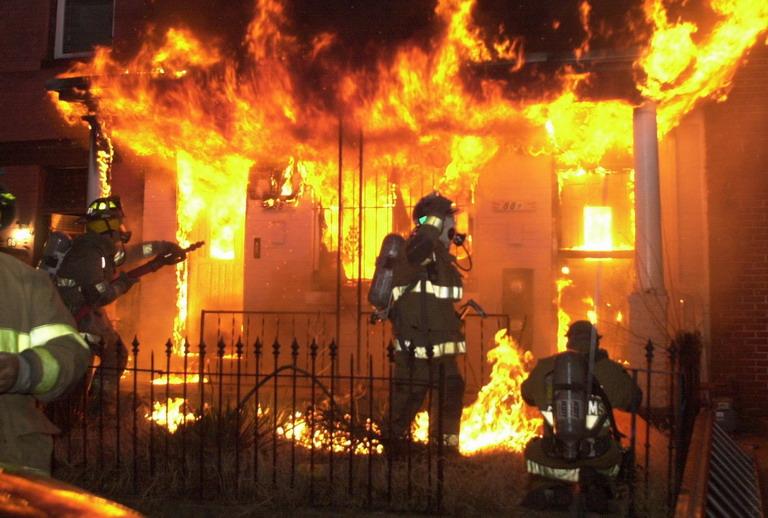
… and, of course, sometimes you just have to come off with that Man’s Line and walk the dog. February 2002 photograph by Mia Aigotti, 1st and P St. NW.
Kevin Byrne
Posts: 91
Threads: 2
Likes Received: 0 in 0 posts
Likes Given: 0
Joined: Oct 2006
Reputation:
0
[quote name='dcfireman' post='137717' date='Aug 7 2007, 02:00 '] ![[Image: attachment.php?thumbnail=22160]](http://firepics.net/MyBB/attachment.php?thumbnail=22160)
… and, of course, sometimes you just have to come off with that Man’s Line and walk the dog. February 2002 photograph by Mia Aigotti, 1st and P St. NW.[/quote]
Man's line. Nice.
Thanks for the awesome explanation Kevin.
Its funny how that is something that is never taught, and actually frowned on. I have pretty much been told that the longest you EVER want to have a 1 1/2 attack line is 200, maybe 250 feet. The explanation was that the high pressures needed make the line almost impossible to work with. But, you guys prove its doable. As one of my favorite instructors says a lot: firefighting is hockey, not ballet.
Rob
Rob Atwater
Lieutenant
Derry Fire
Engine 4/Truck 4
Derry, NH
|






 Facebook
Facebook Google
Google Reddit
Reddit Twitter
Twitter